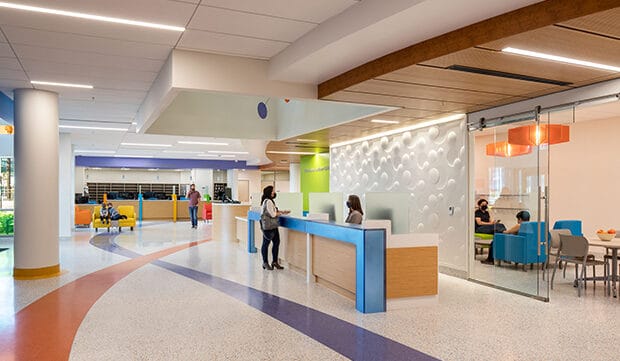Blog
Clean Lines, Organic Forms, and Bold Colors

From common to complex health conditions, it takes a village to care for children. Until now, the outpatient services for Miller Children’s & Women’s Hospital Long Beach in Long Beach, Calif. were delivered across more than 35 clinics, a logistical challenge for families seeking care. From blood draw and imaging to orthopedics, neurology, oncology, and rehabilitation services, families were navigating multiple appointments in different locations on any given day.
The new Cherese Mari Laulhere Children’s Village provides a comprehensive pediatric outpatient destination for the hospital, while also supporting a collaborative, efficient model of care. (Source)
Design Concept Video Tour From c|aARCHITECTS
About the Design
The four-story, 80,000-square-foot building, which is projected to receive LEED Gold certification, leverages its prominent location on the hospital campus’ southeast corner to become a dynamic anchor and to bolster the pediatric focus on campus. The building is organized in an L-shape that minimizes the distance from the entry to patient clinics and maximizes window area to allow natural light to penetrate the building. The main entry sits at the footprint’s inner corner with north and west wings opening toward the core of the medical campus. This creates two primary façades: one facing the city and public ways and the other facing the heart of the medical campus. Colored glass, stair towers, balconies, and a large orange cube at the corner create an engaging elevation, while a sweeping multicolored translucent glass entrance canopy welcomes users into the lobby.
Clean lines, organic forms, and bold colors offer pleasing design elements for all ages while providing intuitive wayfinding cues. For example, colored ribbons integrated into the terrazzo and resilient flooring support circulation and guide patients and families to the various clinics. Arrival areas at the clinics are designated by brightly painted destination walls and complemented by organic forms in the ceilings. Exam room doors and entry flooring are punctuated with different colors as kid-friendly communication tools.
The project team, including C/A Architects (Long Beach, Calif.), used a Lean methodology and design-build approach to deliver the operational vision for the project. The Lean process gave staff a voice in the clinic design and allowed the hospital to refine processes. For example, typically offices sit empty part of the week, averaging 30 to 40 percent utilization. The consolidation of services within a hoteling concept takes advantage of a universal suite design and allows practices to move in and out, as needed. The building can then be used more efficiently by not having space dedicated to one service line or practice, with a better than 80 percent utilization factor anticipated.
Furthermore, employing onstage/offstage spaces for staff improves efficiency and operational costs. The design-build approach also allowed for greater efficiency with the project schedule, resulting in the building being delivered on time and on budget, even during the COVID-19 pandemic.
Project Details
Facility Name: Cherese Mari Laulhere Children’s Village at Miller Children’s & Women’s Hospital Long Beach
Location: Long Beach, Calif.
Completion Date: February 2021
Owner: Miller Children’s & Women’s Hospital Long Beach
Total Building Area: 80,000 sq. ft.
Architect: C/A Architects
Interior Designer: C/A Architects
General Contractor: Turner Construction Co.
Engineers: TK1SC (MEP, lighting), MHP (structural), Madole & Associates (civil)
Builder: Turner Construction Co.
Landscape Architect: Cummings Curley & Associates
LEED: Brightworks Sustainability
Methane Barrier: Kleinfelder
Acoustics: Schwob Acoustics
Signage: SKA Design
Specifications Writing: AWC West
Equipment Consulting: Roloff International
Article Sources:
This post was originally published in Healthcare Design Magazine. See the original here.
Photo by Paul Turang Photography
Marie Wikoff is the creator of Wikoff Design Studio based out of Reno, Nevada. Her expertise in healthcare design has helped modernize healthcare organizations locally, regionally, and internationally, improving patient experience and outcomes. Her credentials include Evidence-Based Design Accreditation and Certification (EDAC), American Academy of Healthcare Interior Designer (CHID), the National Council of Interior Design Qualification (NCIDQ) and LEED AP. Contact Marie Wikoff







